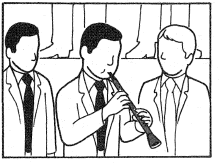Music and Dance
Some directors choose shots ‘spontaneously’; others carefully analyze the performance beforehand. But in the end, the way you stage and shoot music and dance is mainly influenced by the purpose of your program.
Approaches
• If your aim is effect, then you will probably use light to engender mood – dynamic camera movements and ever-changing compositional patterns to enhance musical structure; slow mixes, fast cutting, superimpositions to echo the tempo.
• Where the presentation is more formal, emphasis is on clarity, with the camera concentrating on performance and techniques, rather than dynamics.
Sometimes a particular presentation technique may be used for quite different purposes. Slow motion, for example, can be used to convey a dreamy, languorous mood, or simply to show more clearly the details of fast movements.
It’s important to choose the right transitions; quick cutting for fast sequences, gradual mixes perhaps for slower ones. They must be precisely timed to suit music and action.
occasionally you may use a soft-edged inset, or even a superimposition, to show detail (a soloist) within a general view. But take care that visual gimmicks do not distract from the performance.
Particularly when shooting dance, the secret is to be in the right place at the right time! Long shots show us the overall pattern of movement But are we missing an individual performance that can only be seen in a closer shot? While concentrating on the particular, are we losing the overall impact?
When presenting music (bands, orchestras, groups), it is essential to shoot instruments from appropriate angles. A very narrow lens angle can distort and compress subjects together. Getting the right shot from the right position, at the right, moment, is no mean feat! It needs careful attention to the score, precise planning, and skilled camerawork. There’s nothing more frustrating than cutting to an instrumentalist just as he’s finished playing – or seeing the wrong instrument!
The soloist
Soloists (singers, instrumentalists) can be presented in innumerable ways. Their background might range from neutral to abstract; from a decorative treatment to a realistic environment In location shots, soloists usually perform mime) to tape playback, while walking beaches, wandering in countryside… Occasionally, instead, a series of atmospheric shots (e.g. library film) are used to accompany the performance.
Pop music
Visually, anything goes – all the video effects tricks, speed changes, electronically doctored images, multi-images, quick cutting, bizarre lighting! The aim is to be different; to intrigue, amuse, astonish, shock. Glitzy visuals may make even mundane material arresting.

Closeups
Closeups of performers may be informative, but not particularly attractive.

High shots
High shots can reveal overall pattern and team formations.

Ground shots
Ground shots can show footwork, steps, swirling skirts.

Isolation
When shooting within a group it may be impossible to isolate individual performers so that unwanted items or people appear in shot.
